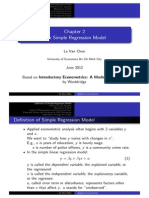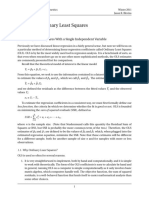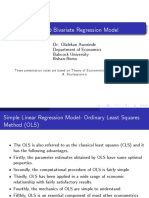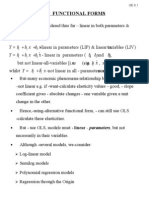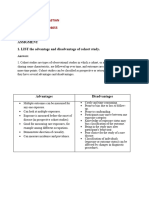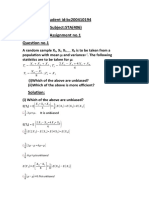Lecture 8
Uploaded by
ABHILASH MSLecture 8
Uploaded by
ABHILASH MSAIL 7310: MACHINE LEARNING FOR ECONOMICS
Lecture 8
11th August, 2023
AIL 7310: ML for Econ Lecture 8 1 / 13
Simple Linear Regression Model
In the last lecture, we derived the sample estimates of βˆ1 and βˆ0 as.
Pn
(x − x̄)(yi − ȳ )
ˆ
β1 = i=1 Pn i 2
(1)
i=1 (xi − x̄)
AIL 7310: ML for Econ Lecture 8 2 / 13
Simple Linear Regression Model
In the last lecture, we derived the sample estimates of βˆ1 and βˆ0 as.
Pn
(x − x̄)(yi − ȳ )
ˆ
β1 = i=1 Pn i 2
(1)
i=1 (xi − x̄)
βˆ0 = ȳ − βˆ1 x̄ (2)
They are called the ordinary least squares estimates of βˆ1 and βˆ0 .
AIL 7310: ML for Econ Lecture 8 2 / 13
Simple Linear Regression Model
To justify this name, for any βˆ1 and βˆ0 define a fitted value for y when
x = xi as
yˆi = βˆ0 + β1ˆxi
This is the value we predict for y when x = xi for the given intercept and
slope. There is a fitted value for each observation in the sample. (Note:
We use the term fitted value here and not predicted value).The residual for
observation i is the difference between the actual yi and its fitted value:
ˆ = yi − βˆ0 − β1ˆxi
ûi = yi − yi
There are n such residuals. (Note: These are not the same as errors in eq.
(1))
AIL 7310: ML for Econ Lecture 8 3 / 13
Simple Linear Regression Model
Now,
Pn suppose we choose βˆ1 and βˆ0 to make the sum of squared residuals
2
i=1 ûi as small as possible. Mathematically,
n
X
min (yi − β0 − β1 xi )2 (3)
β0 ,β1
i=1
The first-order conditions are
n
X
−2 (yi − β0 − β1 xi ) = 0 (4)
i=1
n
X
−2 xi (yi − β0 − β1 xi ) = 0 (5)
i=1
AIL 7310: ML for Econ Lecture 8 4 / 13
Simple Linear Regression Model
Equations (4) and (5) are basically the same equations as eqs. (11) and
(12) from last class which can be solved to give us the ordinary least
squares estimates.
AIL 7310: ML for Econ Lecture 8 5 / 13
Simple Linear Regression Model
Equations (4) and (5) are basically the same equations as eqs. (11) and
(12) from last class which can be solved to give us the ordinary least
squares estimates.
They are called ”ordinary least squares” since they minimize the sum of
squared residuals.
AIL 7310: ML for Econ Lecture 8 5 / 13
Simple Linear Regression Model
Equations (4) and (5) are basically the same equations as eqs. (11) and
(12) from last class which can be solved to give us the ordinary least
squares estimates.
They are called ”ordinary least squares” since they minimize the sum of
squared residuals.
Once we have determined the OLS intercept and slope estimates, we form
the OLS regression line.
AIL 7310: ML for Econ Lecture 8 5 / 13
Simple Linear Regression Model
Equations (4) and (5) are basically the same equations as eqs. (11) and
(12) from last class which can be solved to give us the ordinary least
squares estimates.
They are called ”ordinary least squares” since they minimize the sum of
squared residuals.
Once we have determined the OLS intercept and slope estimates, we form
the OLS regression line.
ŷ = βˆ0 + βˆ1 x (6)
The notation ŷ emphasizes that the predicted values are estimates. The
intercept βˆ0 is the fitted value of y when x = 0.
AIL 7310: ML for Econ Lecture 8 5 / 13
Simple Linear Regression Model
Note: This equation (6) above is the sample regression function (SRF).
This is an estimated version of the population regression function
E (y |x) = β0 + β1 x we has stated earlier. Remember the population
regression line is something fixed. But the SRF is obtained for a given
sample of data, a new sample will generate a different slope and intercept
in eq. (6).
AIL 7310: ML for Econ Lecture 8 6 / 13
Simple Linear Regression Model
Note: This equation (6) above is the sample regression function (SRF).
This is an estimated version of the population regression function
E (y |x) = β0 + β1 x we has stated earlier. Remember the population
regression line is something fixed. But the SRF is obtained for a given
sample of data, a new sample will generate a different slope and intercept
in eq. (6).
The slope estimate can be written as
βˆ1 = ∆ŷ /∆x
This is of primary interest; it tells us the amount by which ŷ changes when
x increases by one unit.
AIL 7310: ML for Econ Lecture 8 6 / 13
Simple Linear Regression:Example
Suppose you take a dataset of 500 people and their data on wage (hourly
in INR) and education (in number of years in school). You fit a simple
linear regression model and obtain the following sample regression
function.
wage
[ = 90 + 154education
AIL 7310: ML for Econ Lecture 8 7 / 13
Simple Linear Regression:Example
Suppose you take a dataset of 500 people and their data on wage (hourly
in INR) and education (in number of years in school). You fit a simple
linear regression model and obtain the following sample regression
function.
wage
[ = 90 + 154education
How do you interpret 90 and 154?
AIL 7310: ML for Econ Lecture 8 7 / 13
Simple Linear Regression:Example
Suppose you take a dataset of 500 people and their data on wage (hourly
in INR) and education (in number of years in school). You fit a simple
linear regression model and obtain the following sample regression
function.
wage
[ = 90 + 154education
How do you interpret 90 and 154?
AIL 7310: ML for Econ Lecture 8 7 / 13
Simple Linear Regression:Example
Suppose you take a dataset of 500 people and their data on wage (hourly
in INR) and education (in number of years in school). You fit a simple
linear regression model and obtain the following sample regression
function.
wage
[ = 90 + 154education
How do you interpret 90 and 154?
Note: In our study so far the slope parameter simply measures the
association between y and x. It says nothing about causality. Even
through we often casually use causal language to talk about β1 (e.g. does
a decrease in price increase sales?) it is important to understand that
causality can only be determined after imposing other conditions.
AIL 7310: ML for Econ Lecture 8 7 / 13
The meaning of ”linear” regression
What does ’linear’ mean in this model?
y = β0 + β1 x + u
AIL 7310: ML for Econ Lecture 8 8 / 13
The meaning of ”linear” regression
What does ’linear’ mean in this model?
y = β0 + β1 x + u
They key here is that this model is linear in the parameters β0 and β1 .
AIL 7310: ML for Econ Lecture 8 8 / 13
The meaning of ”linear” regression
What does ’linear’ mean in this model?
y = β0 + β1 x + u
They key here is that this model is linear in the parameters β0 and β1 .
We can easily use simple linear regression to estimate a √
model where
wage 2
[ = β0 + β1 (education) or consumption = β0 + β1 income
\
AIL 7310: ML for Econ Lecture 8 8 / 13
The meaning of ”linear” regression
What does ’linear’ mean in this model?
y = β0 + β1 x + u
They key here is that this model is linear in the parameters β0 and β1 .
We can easily use simple linear regression to estimate a √
model where
wage 2
[ = β0 + β1 (education) or consumption = β0 + β1 income
\
Infact, we often use this to our advantage to estimate a wide range of
models using a simple linear regression framework.
AIL 7310: ML for Econ Lecture 8 8 / 13
Different functional forms
In the previous example we saw that each additional year of education
increases hourly wage by 154 Rupees. Here the rate of change is same for
the first year of education or the twelfth year. This may not be entirely
realistic. Perhaps a better characterization would be increases in a
percentage.A model that gives (approximately) a constant percentage
effect is
AIL 7310: ML for Econ Lecture 8 9 / 13
Different functional forms
In the previous example we saw that each additional year of education
increases hourly wage by 154 Rupees. Here the rate of change is same for
the first year of education or the twelfth year. This may not be entirely
realistic. Perhaps a better characterization would be increases in a
percentage.A model that gives (approximately) a constant percentage
effect is
log (wage) = β0 + β1 education + u
where log (.) denotes the natural logarithm.
AIL 7310: ML for Econ Lecture 8 9 / 13
Different functional forms
In the previous example we saw that each additional year of education
increases hourly wage by 154 Rupees. Here the rate of change is same for
the first year of education or the twelfth year. This may not be entirely
realistic. Perhaps a better characterization would be increases in a
percentage.A model that gives (approximately) a constant percentage
effect is
log (wage) = β0 + β1 education + u
where log (.) denotes the natural logarithm.
Then,
%∆wage ≈ (100 ∗ β1 )∆education
AIL 7310: ML for Econ Lecture 8 9 / 13
Different functional forms
There are four commonly used functional forms in econometrics.
AIL 7310: ML for Econ Lecture 8 10 / 13
Different functional forms
There are four commonly used functional forms in econometrics.
Model Dependent Var. Independent Var. Interpretation
Level-level y x ∆y = β1 ∆x
Level -log y log(x) ∆y = (β1 /100)%∆x
Log - level log(y) x %∆y = (100β1 )∆x
Log-log log(y) log(x) %∆y = β1 %∆x
AIL 7310: ML for Econ Lecture 8 10 / 13
Different functional forms
There are four commonly used functional forms in econometrics.
Model Dependent Var. Independent Var. Interpretation
Level-level y x ∆y = β1 ∆x
Level -log y log(x) ∆y = (β1 /100)%∆x
Log - level log(y) x %∆y = (100β1 )∆x
Log-log log(y) log(x) %∆y = β1 %∆x
In the log-level model, 100.β1 is sometimes called the semi-elasticity of y
with respect to x.
AIL 7310: ML for Econ Lecture 8 10 / 13
Different functional forms
There are four commonly used functional forms in econometrics.
Model Dependent Var. Independent Var. Interpretation
Level-level y x ∆y = β1 ∆x
Level -log y log(x) ∆y = (β1 /100)%∆x
Log - level log(y) x %∆y = (100β1 )∆x
Log-log log(y) log(x) %∆y = β1 %∆x
In the log-level model, 100.β1 is sometimes called the semi-elasticity of y
with respect to x.
In the log-log model, β1 is called the elasticity of y with respect to x.
AIL 7310: ML for Econ Lecture 8 10 / 13
Multiple Linear Regression
Now, we move on to more realistic models - the multiple linear regression
model. Here, we incorporate multiple (k) explanatory variables.
AIL 7310: ML for Econ Lecture 8 11 / 13
Multiple Linear Regression
Now, we move on to more realistic models - the multiple linear regression
model. Here, we incorporate multiple (k) explanatory variables.
y = β0 + β1 x1 + β2 x2 + ...βk xk + u (7)
AIL 7310: ML for Econ Lecture 8 11 / 13
Multiple Linear Regression
Now, we move on to more realistic models - the multiple linear regression
model. Here, we incorporate multiple (k) explanatory variables.
y = β0 + β1 x1 + β2 x2 + ...βk xk + u (7)
Here, β0 is the intercept, β1 is the change in y with respect to x1 holding
other factors fixed, β2 is the change in y with respect to x2 holding other
factors fixed and so on.
AIL 7310: ML for Econ Lecture 8 11 / 13
Multiple Linear Regression
The key assumption here is
E (u|x1 , x2 , ..., xk ) = 0 (8)
AIL 7310: ML for Econ Lecture 8 12 / 13
Multiple Linear Regression
The key assumption here is
E (u|x1 , x2 , ..., xk ) = 0 (8)
which is the multiple linear regression counterpart of the zero conditional
mean assumption. This assumption implies that all factors in the
unobserved error term are uncorrelated with the explanatory variables.
AIL 7310: ML for Econ Lecture 8 12 / 13
Obtaining the OLS Estimates
Similar to the simple linear regression case, the OLS estimates (k+1) of
them are chosen to minimize the sum of squared residuals:
n
X
(yi − β0 − β1 xi1 − ...βk xik )2 (9)
i=1
The first-order conditions will be a set of k+1 linear equations in k+1
unknowns which can be solved to get the OLS estimates βˆ0 , βˆ1 , ...βˆk .
AIL 7310: ML for Econ Lecture 8 13 / 13
You might also like
- Get Practical Multilevel Modeling Using R (Advanced Quantitative Techniques in the Social Sciences) 1st Edition Huang free all chapters100% (5)Get Practical Multilevel Modeling Using R (Advanced Quantitative Techniques in the Social Sciences) 1st Edition Huang free all chapters64 pages
- Belisa Aliyi - Assignments - For - EconometricsNo ratings yetBelisa Aliyi - Assignments - For - Econometrics34 pages
- Introduction To Econometrics (ET2013) : Teresa RandazzoNo ratings yetIntroduction To Econometrics (ET2013) : Teresa Randazzo30 pages
- Lecture3-Enriching the Linear Models Slides-AnnotatedNo ratings yetLecture3-Enriching the Linear Models Slides-Annotated42 pages
- Regression: Dr. Agustinus Suryantoro, M.SNo ratings yetRegression: Dr. Agustinus Suryantoro, M.S31 pages
- As of Sep 16, 2020: Seppo Pynn Onen Econometrics INo ratings yetAs of Sep 16, 2020: Seppo Pynn Onen Econometrics I52 pages
- Lecture8-Estimating the Linear Causal Model I -Slides annotatedNo ratings yetLecture8-Estimating the Linear Causal Model I -Slides annotated27 pages
- Ordinary Least Squares With A Single Independent VariableNo ratings yetOrdinary Least Squares With A Single Independent Variable6 pages
- Simple Linear Regression (Chapter 11) : Review of Some Inference and Notation: A Common Population Mean ModelNo ratings yetSimple Linear Regression (Chapter 11) : Review of Some Inference and Notation: A Common Population Mean Model24 pages
- Econometrics Lecture4 MultipleRegressionNo ratings yetEconometrics Lecture4 MultipleRegression40 pages
- STAT 135: Linear Regression: Joan BrunaNo ratings yetSTAT 135: Linear Regression: Joan Bruna232 pages
- LinearRegression_FoundationalMathofAI_S24No ratings yetLinearRegression_FoundationalMathofAI_S244 pages
- Simple Linear Regression and Multiple Linear Regression: MAST 6474 Introduction To Data Analysis INo ratings yetSimple Linear Regression and Multiple Linear Regression: MAST 6474 Introduction To Data Analysis I15 pages
- Extensions of The Two-Variable Linear Regression Model and Finding OutliersNo ratings yetExtensions of The Two-Variable Linear Regression Model and Finding Outliers17 pages
- Econ452: Problem Set 2: University of Michigan - Department of EconomicsNo ratings yetEcon452: Problem Set 2: University of Michigan - Department of Economics4 pages
- Lecture4-Estimating the Linear Conditional Mean Model I - Slides-AnnotatedNo ratings yetLecture4-Estimating the Linear Conditional Mean Model I - Slides-Annotated33 pages
- Module 2b - Bivariate Association of Data - Part IINo ratings yetModule 2b - Bivariate Association of Data - Part II25 pages
- The Simple Regression Model: DR Jin Hongfei 1No ratings yetThe Simple Regression Model: DR Jin Hongfei 141 pages
- Lecture 2-2_Simple Linear Regression (One Regressor)No ratings yetLecture 2-2_Simple Linear Regression (One Regressor)22 pages
- Introductory Econometrics: Chapter 2 SlidesNo ratings yetIntroductory Econometrics: Chapter 2 Slides31 pages
- (Indian Economics Services) (Econometrics) 05. Functional Forms of Regression Models PDFNo ratings yet(Indian Economics Services) (Econometrics) 05. Functional Forms of Regression Models PDF8 pages
- Student's Solutions Manual and Supplementary Materials for Econometric Analysis of Cross Section and Panel Data, second editionFrom EverandStudent's Solutions Manual and Supplementary Materials for Econometric Analysis of Cross Section and Panel Data, second editionNo ratings yet
- PDF An Introduction to Econometrics A Self Contained Approach 1st Edition Frank Westhoff download100% (4)PDF An Introduction to Econometrics A Self Contained Approach 1st Edition Frank Westhoff download81 pages
- EPIDEMIOLOGY ASSIGNMENT - Advantages and Disadvantages of Cohort StudyNo ratings yetEPIDEMIOLOGY ASSIGNMENT - Advantages and Disadvantages of Cohort Study2 pages
- Lecture 8. Confidence Intervals for the MeanNo ratings yetLecture 8. Confidence Intervals for the Mean87 pages
- Deviation From Ideal Gas Behavior: Xi FDC Chemistry Chapter 4: Gases Sidra JavedNo ratings yetDeviation From Ideal Gas Behavior: Xi FDC Chemistry Chapter 4: Gases Sidra Javed14 pages
- Partition Function of 1-, 2-, and 3-D Monatomic Ideal Gas: A Simple and Comprehensive ReviewNo ratings yetPartition Function of 1-, 2-, and 3-D Monatomic Ideal Gas: A Simple and Comprehensive Review4 pages
- Lecture #13 - Finish Sexual Selection & Genetic DriftNo ratings yetLecture #13 - Finish Sexual Selection & Genetic Drift63 pages
- Student Id:bc 200410194 Subject:STA (406) Assignment No.1 Question No.1No ratings yetStudent Id:bc 200410194 Subject:STA (406) Assignment No.1 Question No.13 pages
- Analisis Bivariat Pengaruh: CorrelationsNo ratings yetAnalisis Bivariat Pengaruh: Correlations3 pages
- Relation Between GDP and FCE of India: Harjas Singh SahniNo ratings yetRelation Between GDP and FCE of India: Harjas Singh Sahni14 pages
- CA4229 Week 3 Land Use Planning - Applied ValNo ratings yetCA4229 Week 3 Land Use Planning - Applied Val69 pages
- Get Practical Multilevel Modeling Using R (Advanced Quantitative Techniques in the Social Sciences) 1st Edition Huang free all chaptersGet Practical Multilevel Modeling Using R (Advanced Quantitative Techniques in the Social Sciences) 1st Edition Huang free all chapters
- Introduction To Econometrics (ET2013) : Teresa RandazzoIntroduction To Econometrics (ET2013) : Teresa Randazzo
- Lecture3-Enriching the Linear Models Slides-AnnotatedLecture3-Enriching the Linear Models Slides-Annotated
- As of Sep 16, 2020: Seppo Pynn Onen Econometrics IAs of Sep 16, 2020: Seppo Pynn Onen Econometrics I
- Lecture8-Estimating the Linear Causal Model I -Slides annotatedLecture8-Estimating the Linear Causal Model I -Slides annotated
- Ordinary Least Squares With A Single Independent VariableOrdinary Least Squares With A Single Independent Variable
- Simple Linear Regression (Chapter 11) : Review of Some Inference and Notation: A Common Population Mean ModelSimple Linear Regression (Chapter 11) : Review of Some Inference and Notation: A Common Population Mean Model
- Simple Linear Regression and Multiple Linear Regression: MAST 6474 Introduction To Data Analysis ISimple Linear Regression and Multiple Linear Regression: MAST 6474 Introduction To Data Analysis I
- Extensions of The Two-Variable Linear Regression Model and Finding OutliersExtensions of The Two-Variable Linear Regression Model and Finding Outliers
- Econ452: Problem Set 2: University of Michigan - Department of EconomicsEcon452: Problem Set 2: University of Michigan - Department of Economics
- Lecture4-Estimating the Linear Conditional Mean Model I - Slides-AnnotatedLecture4-Estimating the Linear Conditional Mean Model I - Slides-Annotated
- Module 2b - Bivariate Association of Data - Part IIModule 2b - Bivariate Association of Data - Part II
- Lecture 2-2_Simple Linear Regression (One Regressor)Lecture 2-2_Simple Linear Regression (One Regressor)
- (Indian Economics Services) (Econometrics) 05. Functional Forms of Regression Models PDF(Indian Economics Services) (Econometrics) 05. Functional Forms of Regression Models PDF
- Student's Solutions Manual and Supplementary Materials for Econometric Analysis of Cross Section and Panel Data, second editionFrom EverandStudent's Solutions Manual and Supplementary Materials for Econometric Analysis of Cross Section and Panel Data, second edition
- PDF An Introduction to Econometrics A Self Contained Approach 1st Edition Frank Westhoff downloadPDF An Introduction to Econometrics A Self Contained Approach 1st Edition Frank Westhoff download
- EPIDEMIOLOGY ASSIGNMENT - Advantages and Disadvantages of Cohort StudyEPIDEMIOLOGY ASSIGNMENT - Advantages and Disadvantages of Cohort Study
- Deviation From Ideal Gas Behavior: Xi FDC Chemistry Chapter 4: Gases Sidra JavedDeviation From Ideal Gas Behavior: Xi FDC Chemistry Chapter 4: Gases Sidra Javed
- Partition Function of 1-, 2-, and 3-D Monatomic Ideal Gas: A Simple and Comprehensive ReviewPartition Function of 1-, 2-, and 3-D Monatomic Ideal Gas: A Simple and Comprehensive Review
- Lecture #13 - Finish Sexual Selection & Genetic DriftLecture #13 - Finish Sexual Selection & Genetic Drift
- Student Id:bc 200410194 Subject:STA (406) Assignment No.1 Question No.1Student Id:bc 200410194 Subject:STA (406) Assignment No.1 Question No.1
- Relation Between GDP and FCE of India: Harjas Singh SahniRelation Between GDP and FCE of India: Harjas Singh Sahni






